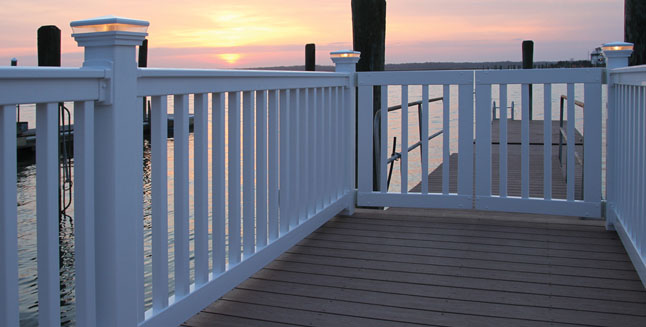You may think that choosing between a fence or railing for your home improvement project or contractor job is simple. In fact, “fence” and “railing” are words that are often used interchangeably even though they are not the same. Several factors need to be taken into consideration before making your decision, including knowing the proper terminology, or you could find yourself in a difficult position. Choosing the wrong product for the job type or space can be costly, unsightly, and inconvenient to correct. It can even be dangerous or cause you liability if you make a mistake. Here’s what you need to know to get it right the first time.
Reasons to Get It Right
It would be difficult to resell your property if you do it wrong and the railing or fence does not meet code. Home inspections often reveal code violations, which can cause potential contracts to fall through.
Consider the space where you will be installing a fence or railing. If you’re building around a patio, a deck, or another outdoor living space, then you need a railing, not a fence.
Also, take into account aesthetic appeal. A fence or railing where it should not be will look odd or out of place.
The most important reason to make sure you purchase the right product - If someone were to fall, and the wrong product is mounted, it might not hold, and at certain heights, it could lead to serious injuries. Keep in mind that railings are designed to withstand people leaning on them.
Height Makes Right
Decks
Your local building code will always be your best resource on the rules and regulations for your area. That being said, typically, If the deck is higher than 30” above grade, a railing is required. Decks that are attached to single-family detached homes are regulated under the International Residential Code (IRC), which requires guardrails to be at least 36” in height, from deck surface to the top of the rail. Commercial decks attached to multi-family buildings, such as apartment homes or businesses, are regulated under the International Building Code (IBC), which requires 42” high guardrails.
Porches
The same rules apply to porches; if your porch is not more than 30” off the ground, a railing is not required. However, something to keep in mind before deciding to skip the railing is safety. Family members, kids, and pets can still fall off a deck that is less than 30” off the ground and hurt themselves. Also, you may find that a well-designed railing can put a nice finishing touch on your brand-new porch.
Balconies
The IRC defines balconies as a structure that is supported only on one side where it attaches to an upper story of a building. Again, if the balcony is 30” or more above ground, a railing is required and must be installed at a height of 36” above the balcony floor. Additionally, railings and balusters must be spaced at intervals of no more than 4 inches, and any gap between the floor and the lower edge of the toe-board cannot exceed 4 inches.
What Does Your Local Code Say?
The guidelines described above are general rules. Always keep in mind that some local jurisdictions or states may have different requirements. That’s why it’s important to always double-check your local code and regulations before making your purchase.
Other Things to Consider
Railing and fences are designed for different purposes. For example, if the area is also a driveway or a walkway with some height, it might need railing. However, if the area is on the defining line of a property, will be surrounding an area such as a pool, or flat ground on both sides, then you can use a fence. Fencing is typically used as a barrier, for privacy, or for both. Railing systems often act as a safety measure, which is why they have to comply with IRC and IBC regulations. Fence zoning codes and rules vary by locality, so it’s always best to start your project at your local building department office or by visiting the city website for any specific requirements.
We offer a host of additional resources on our website, including helpful checklists for fencing and railing projects, to get you started in the right direction.


